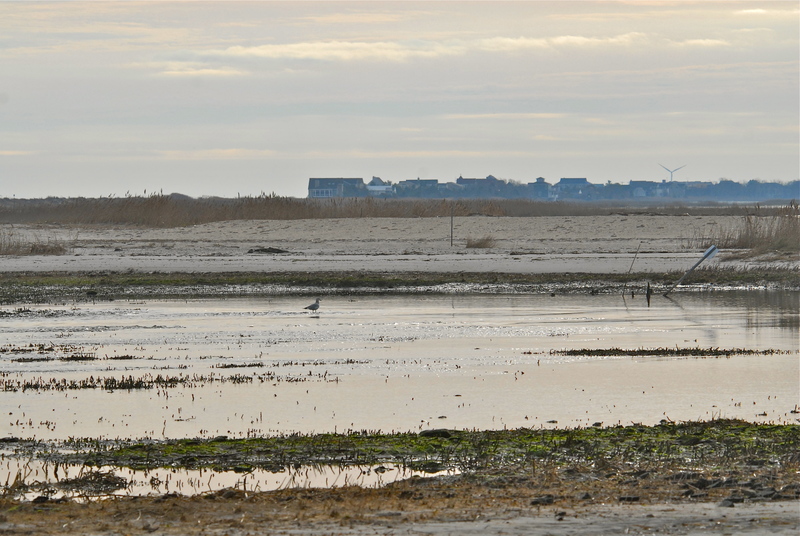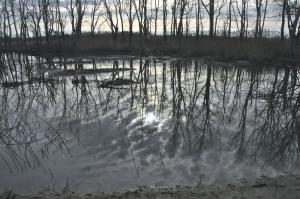Primehook Beach residents have a very short Christmas list: they want sand, and lots of it to fill breaches along the shoreline north of the small Delaware Bay beach town. The constant ebb and flow of tidal water from the Delaware Bay threatens the community with flooding at every high tide, let alone what could happen during a coastal storm.
But it doesn't appear their wish is going to come true any time soon.
Still, a short-term path forward has been set to deal with flooding. Sen. Gary Simpson, R-Milford, said a plan was put into place at a Dec. 13 meeting of federal, state and county officials. Part of that plan includes investigating replenishment of Fowler Beach to repair breaches along the shoreline of Prime Hook National Wildlife Refuge.
Simpson said the project to rebuild the beach would cost more than $6 million, but he went to the Dec. 13 meeting prepared to begin the process to look for funding. However, he said, the idea could conflict with a proposed federal management plan that sets marsh restoration as the highest priority.
“What's really distressing to me is that there is not a short-term fix, which people want,” Simpson said. “People want the dunes repaired as quickly as possible, but I don't see a way to make that happen any time soon.”
Simpson questions the science behind that plan. “About 5,000 acres of marsh has totally deteriorated and sunk eight to 10 inches over the years. I'm told that the marsh has lost its ability to drain as a normal marsh would,” he said.
The breaches have been opened by a series of storms over the past four years allowing the free flow of saltwater into a manmade freshwater impoundment known as Unit 2 within Prime Hook National Wildlife Refuge. The freshwater marsh grass has been destroyed, and the once vibrant marsh is now mostly open water. The protection the marsh once offered to the town and Prime Hook Road, the only public access to the town, is greatly diminished.
Simpson said the committee reached the following decisions:
• At the direction of Gov. Jack Markell, state and federal officials will prepare an application for federal funds to replace culverts under Prime Hook Road, allowing for improved water flow between the northern and southern sides of the road in an effort to reduce flooding over the road, which is the only public access to the town.
• Simpson and Rep. Harvey Kenton, R-Milford, will host a forum in early 2012 presented by the U.S. Fish and Wildlife Service to discuss issues in the area. The service manages Prime Hook National Wildlife Refuge where the breaches are located. The refuge also borders the bay village on three sides.
• State transportation officials will continue to evaluate the potential use of a private road from Broadkill Beach to Primehook Beach as a state-maintained access for Primehook residents.
• Sussex County emergency officials will continue to work with state officials to maintain access to Primehook when Prime Hook Road is impassable.
The plan was enacted as U.S. Fish and Wildlife officials work toward completion of a comprehensive management plan for the refuge.
Michael Stroeh, manager of Prime Hook and Bombay Hook refuges, told officials Prime Hook's comprehensive plan will be completed in late 2012. He said the plan would not only provide a roadmap for restoring the marsh to a more balanced and sustainable state, but it would also provided federal environmental clearance for any work to occur in the refuge, including any potential action to repair breaches.
An email from Markell's office as a follow-up to the meeting states: “This timeframe is longer than the congressional, state and local officials in attendance had hoped and certainly will be disappointing to the residents.”
The meeting was attended by Markell representatives, Kenton, Simpson and representatives from Sen. Tom Carper, Sen. Chris Coons, Rep. John Carney, Delaware Department of Transportation, Department of Natural Resources and Environmental Control, Sussex County and U.S. Fish and Wildlife.
Dredging surfaces as only alternative
Primehook Beach resident John Robinson has been on a campaign to get answers from state officials regarding the fate of his town.
In a recent letter to Robinson, DNREC Secretary Collin O'Mara said dredging sand is the only viable alternative remaining to provide the 21,700 cubic yards of sand needed to repair the Fowler Beach inlets. Officials at the Dec. 13 meeting agreed and are working toward a plan to use dredged materials from Delaware River dredging projects to rebuild beaches and marshes.
O'Mara said trucking in the required sand – an option suggested by residents – would cost $500,000 in delivery costs alone and take more than two months to complete. It would take another two months to rebuild the beach at additional cost, O'Mara said. In addition, he said, DelDOT has determined Fowler Beach Road would need extensive upgrades to allow fully loaded dump trucks access to the beach.
Moving in the sand would be no small task. The amount of sand needed – 21,700 cubic yards – would weigh about 56 million pounds or about 28,000 tons. Depending on the size of the dump truck, as many as 1,400 loads would be needed to rebuild the beach.
“The governor and I are well aware and focused on the issues affecting Prime Hook, despite any suggestions to the contrary,” O'Mara wrote to Robinson in November. “To be clear, the recent flooding in the area is due to the combination of decades of coastal change, the recent intense storms, the tides, the wind that breached the very slim strip of land between the bay and marsh and sea-level rise.
“While this is not comforting to hear, there is no easy solution or immediate action that can legally be taken at this time to prevent flooding at Prime Hook over the next few months,” O'Mara said. “Potential long-term solutions, including using dredged sand to address the issue, would require time to obtain needed permits, are expensive and would require the agreement of the federal government as the landowner.”
O'Mara also said Fowler Beach is not state land, and recent work there was done under permits secured by the U.S. Fish and Wildlife Service, managers of Prime Hook National Wildlife Refuge.
A DNREC crew attempted to slow down the ebb and flow of the bay tide into the Unit 2 impoundment, but the work was undone by the first high tide – in less than a week. Part of that situation can be tied to the loss of approximately 20,000 cubic yards of sand caused by Hurricane Irene.
O'Mara said about 27,000 cubic yards of sand above high mean water was available at Fowler Beach prior to the storm. “Even with this modest amount of material, we believed that the level of protection provided by this sill would be modest, and would have been unlikely to last through a typical winter storm season,” O'Mara said.
Following Hurricane Irene, only 5,300 cubic yards of recoverable sand remained, O'Mara said.
O'Mara said DNREC has prepared a management plan for the Delaware Bay beaches, which includes designs for beach/dune projects to provide protection for five to 10 years. O'Mara said Slaughter Beach and Primehook Beach were included in the analysis, but Fowler Beach was not. However, DNREC officials are now looking at a plan to use dredged material at Fowler.






















































